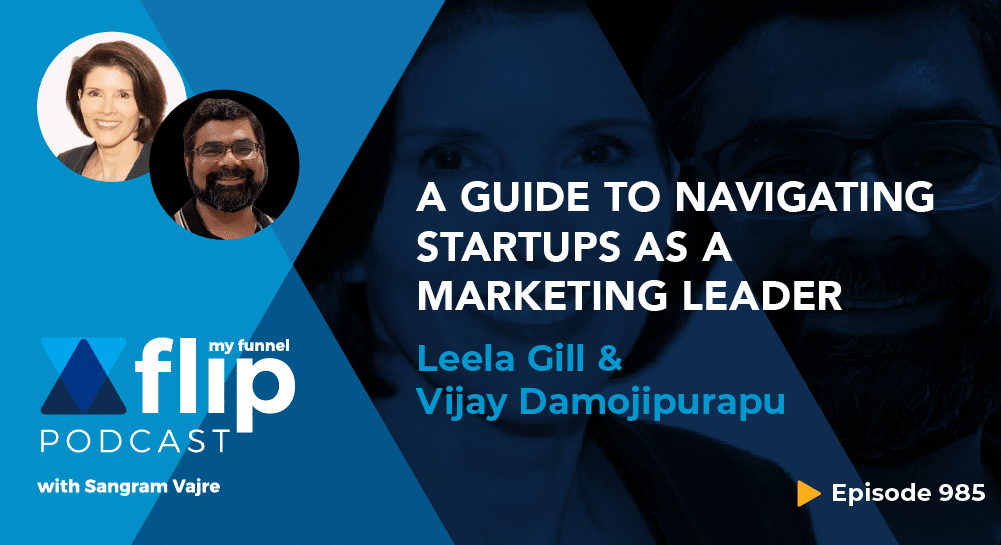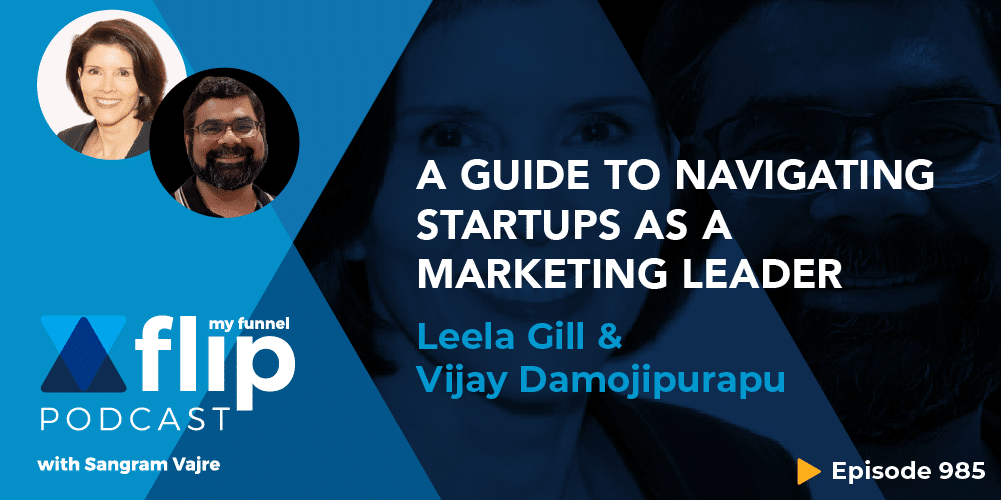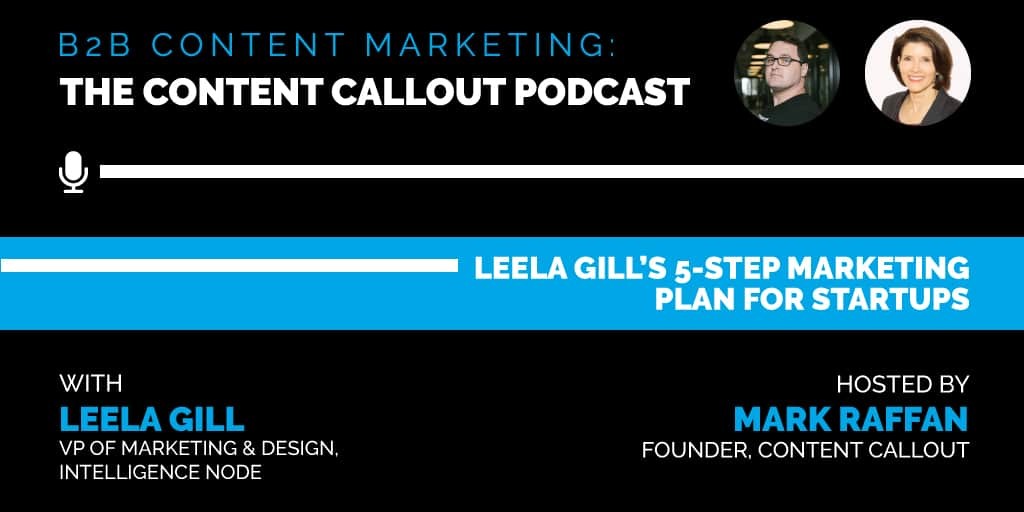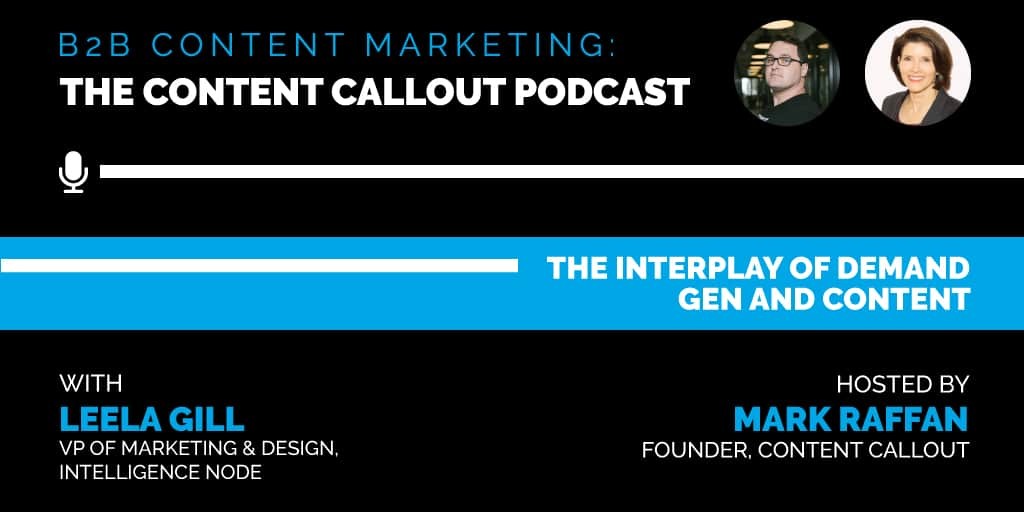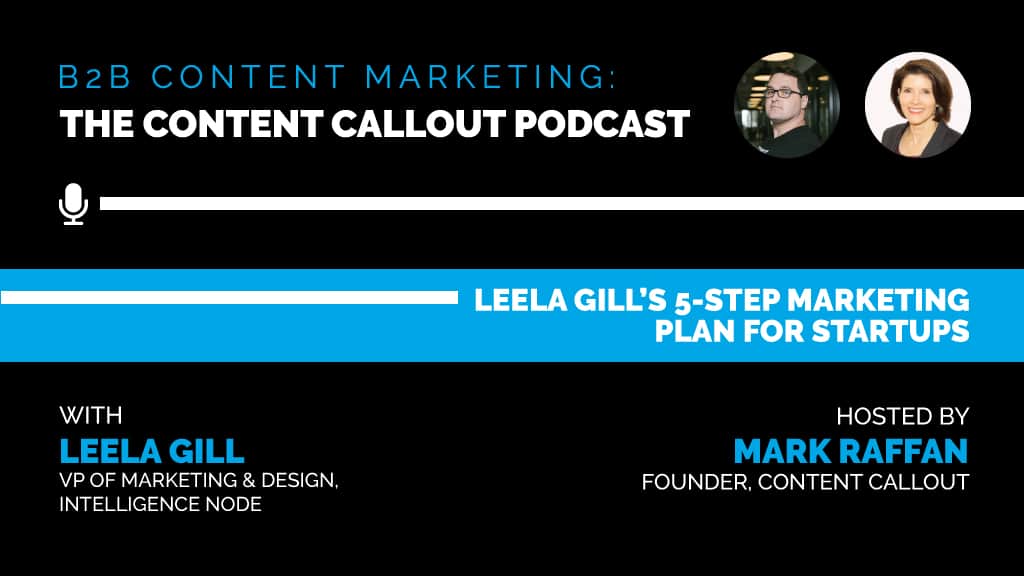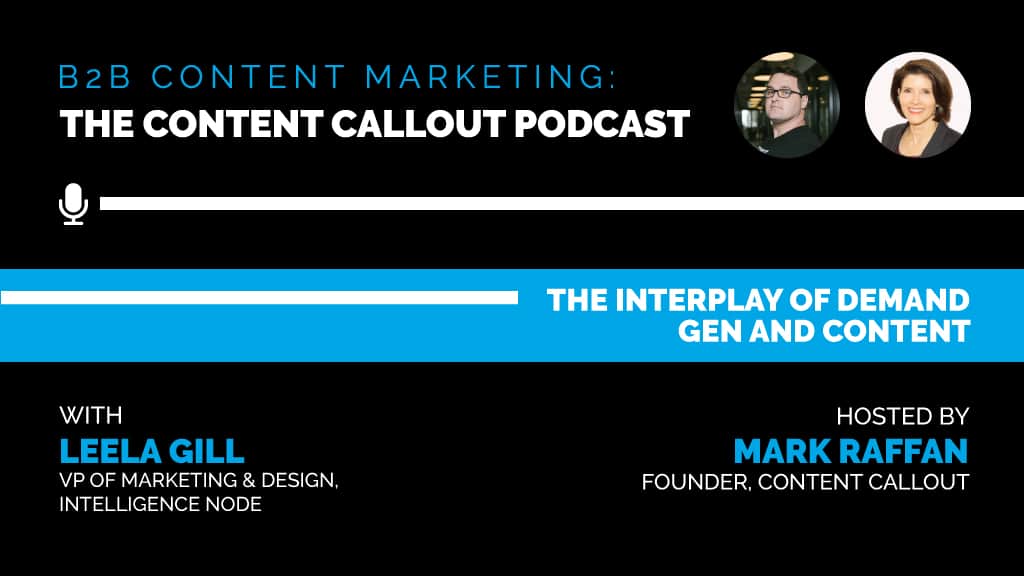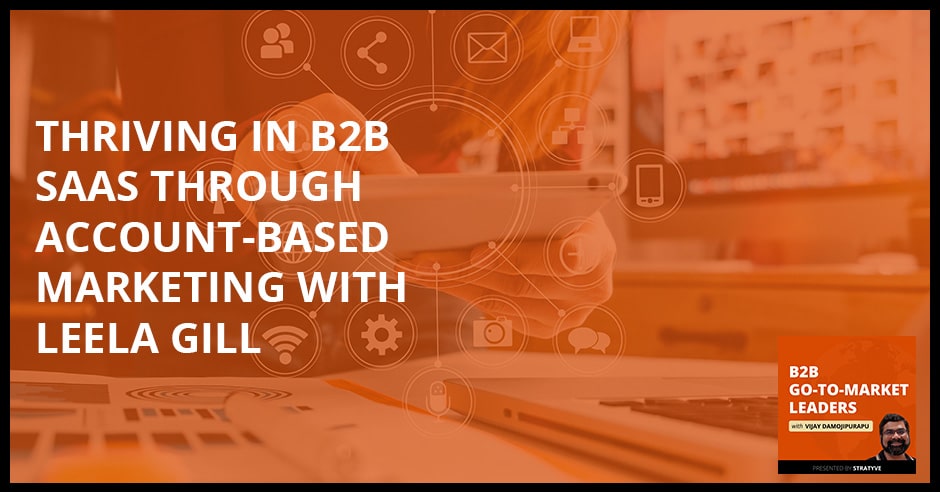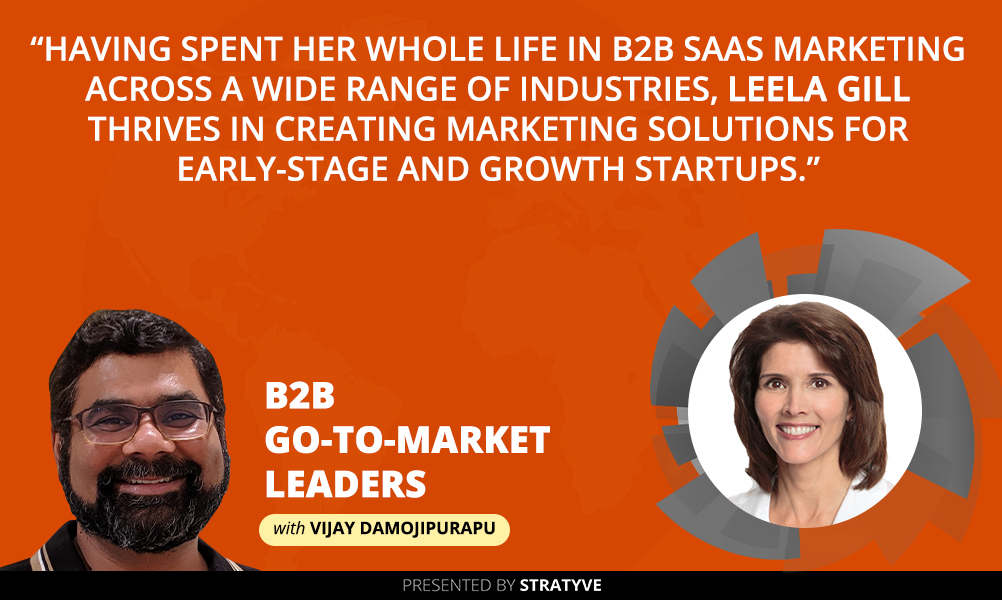A Guide To Navigating Startups as a Marketing Leader
It can’t be understated: Being a marketing leader of a startup can be crazy and chaotic. Out of the million tech startups formed every year, only 60% make it to series A, 20% make it to series B, and only 200 go IPO. The good news, however, is that once you make it, you have a strong chance of continued success.
Our guests today, Leela Gill, VP of Marketing & Design at Intelligence Node, and Vijay Damojipurapu, Founder and Principal at Stratyve, share two strategies to help grow your business and reinforce your position as a marketing leader.
Understanding what makes early stage company success so difficult
If you’re a leader in marketing trying to build a startup, it’s going to come with it’s fair share of hurdles; and with so little chance of success, it’s crucial to know the steps to take to be within the lucky few. For Leela, she connects the scenario to that of baby sea turtles making their way to the ocean — while the odds are stacked against them, the turtles that make it will live long and prosperous lives.
And to drive home just how important marketing is to the success of the business, a startup incubator in the San Francisco Bay area, called Wilbur Labs, recently surveyed over 150 founders. After collecting the results, they found that marketing ranked consistently higher than the product in regards to business success. If you’re looking to invest your time, make sure marketing is on the table.
Honing in on what specifically a marketer can do
Leela and Vijay recognize that investors will look at a few key factors when decisions are made: Leadership team skill, product power, market disruption, and how large the market is. While important, they’re looking to help enact change specifically as a marketer.
”We’re going to try to hone in on what you, specifically as a marketing leader, can do to help your company grow and thrive in this crazy competitive world of early stage business.” — Leela Gill
The operating framework
In the same way that we all know some of the more obvious ways to lose weight, like exercise and eating healthier food, the framework that Leela shares might have seemingly obvious, but often ignored, advice.
Time
Recognized as the first leg of the framework, this means to put together a formal quarterly cadence calendar that speaks to three different groups: The executive stakeholders, specific team members, and customers.
And, while there’s a high possibility that a similar setup is already in place, Leela warns that those meetings tend to focus on what to sell to the board rather than problem solving.
Money
Many startups don’t have the luxury of having millions or even one million to spend on marketing. Despite the desire to spend money on everything in the beginning, it’s important to invest in demand gen instead.
”When you have a limited budget, you have to really put the blinders on, focus, and make sure you’re executing that budget in a very prioritized way with respect to the pipeline.” — Leela Gill
Focus
This is more than just goal setting, it’s focusing on your exit criteria — what is going to help you survive as you transition to the next stage? If you get to series C, you’ll need to have documented processes in place.
The growth flywheel
Once you have the framework in place, where do you go from there? There has to be a way to push the boundaries to think and act differently. Vijay’s suggestion: You need an all-star CMO to pave the way for your team.
”Winning CMOS are consistent; they know it’s going to take a long time and they’re in it for the long haul.” — Vijay Damojipurapu
After interviewing several exceptional CMO’s, Vijay boiled down the insights:
- Content: The currency of a go-to-market machine. Used to earn credibility and trust.
“The content has to be unique, but it also has to be done on a consistent basis,” Vijay explains.
- Experiences: The CMO’s ability to create memorable events that focus on industry problems or speaking to the competitive ecosystem.
- Community: Sharing common pursuits and improving on a daily basis within the organization.
A key takeaway
Creating a successful tech startup can be a near impossible task. Arming yourself with the best strategies, like the operating framework paired with the growth flywheel, can give you the competitive edge that sets you apart from the crowd.
Related Posts:
Influencers, Brand Ambassadors and Raving Fans – and Why You Need All Three
For marketers, influencers, brand ambassadors, and raving fans can create a significant differentiator…
Marketing as a Revenue Generator and Catalyst for Change
Marketing is a change catalyst, calling customers to change and jump on, and it also helps the organization…
A Guide To Navigating Startups as a Marketing Leader
It can’t be understated: Being a marketing leader of a startup can be crazy and chaotic. Out of the million…
A 5-Step Marketing Plan for Startups
As a marketing professional working in a startup, do you know how to help your company grow revenue? How is…
Building A Diverse And Equitable Business: The Role Of Marketing
Jesse Jackson once said, “Inclusion is not a matter of political correctness. It is the key to growth.” This…
B2B Marketing: What We Can Do To Help Save The Planet
The COVID-19 pandemic is the biggest business challenge of a generation. Organizations scramble to establish…
The Interplay of Demand Gen and Content with Leela Gill
The COVID-19 pandemic is the biggest business challenge of a generation. Organizations scramble to establish…
Early-Stage Marketing: A Five-Point Leadership Framework
The COVID-19 pandemic is the biggest business challenge of a generation. Organizations scramble to establish…
Social Media: Getting Above the Noise
The COVID-19 pandemic is the biggest business challenge of a generation. Organizations scramble to establish…
A 5-Step Marketing Plan for Startups
As a marketing professional working in a startup, do you know how to help your company grow revenue? How is your process different from marketing for an established business? In this episode, Leela Gill drops some absolute gems when she describes her marketing plan for Series A and Series B startups. If you’re trying to get your marketing off the ground and running, don’t miss this episode!
Outline of This Episode
- [1:10] Why Leela created her cheat-sheet
- [2:35] Step One: Audit where you currently stand
- [5:02] Step Two: Understand your budget + costs
- [9:06] Step Three: Understand your team’s skillset
- [12:21] Step Four: Think about the big picture
- [16:54] Step Five: What are your exit criteria?
- [19:03] Metrics that matter for scaling up
#1: Audit where you currently stand
The first step in Leela’s plan is auditing where you currently stand. It’s a step that every marketing leader does when they come into a company. But Leela advises auditing every quarter. It involves looking at your ideal customer profile and personas and making sure they’re correct. Does your value proposition work? You have to look at the fundamentals. Then look at your CRM and make sure it’s functioning properly. Encourage your team to be problem solvers.
#2: Understand your budget + costs
You need to understand your budget, costs, conversion rates, and the ecosystem you have to operate in. In a Series A/Series B, your budget can be very constrained. It’s unlikely that you’ll have large tech stacks and an unlimited marketing budget. If that’s your environment, you’re lucky because it’s uncommon. You have to figure out how to make the most of the budget you get, right? Leela usually allocates 40–45% of her budget to headcount and the rest to programs. You need to split your budget in a way that gets you people power and program power to execute. Listen to learn more about what Leela means by that!
#3: Understand your team’s skillsets and strengths
Put people in places where they’re strong. Don’t force people to learn by throwing them in the fire and seeing if they’ll survive. If you don’t have a strong subject matter expert (SME), find a content person that can execute within that area of expertise. Leela does quarterly performance reviews with her team members. In an early-stage company, you can’t wait a full year to review where your content, performance, budgets, and team skill sets are at.
#4: Think about the big picture
Every business is in business to grow revenue, but it’s especially important in the early stages of a business. Leela takes revenue, conversion numbers, conversions rates, etc., to work backward to determine what MQLs/SQLs will be. Then she maps targets to specific programs. If you need 200 leads per week, how will you drive them? How did you do last quarter? Did you hit your numbers? Why did you or didn’t you? Asking the right questions helps you determine what you need to do more of.
#5: What are your exit criteria?
Your goal as a marketer in Series B is to help your company get to Series C or exit the process. In Series A, you need to test your frameworks, understand what’s working, test your ICP and understand your personas, etc. You need a model in place to understand how many leads you’re bringing in. The next logical step is to grow. Series B is all about scaling. If you have a segmented database, make sure a process and cadence are in place to scale and get to Series C.
Leela takes a deep dive into each of these steps in this episode. Don’t miss it!
Related Posts:
Influencers, Brand Ambassadors and Raving Fans – and Why You Need All Three
For marketers, influencers, brand ambassadors, and raving fans can create a significant differentiator…
Marketing as a Revenue Generator and Catalyst for Change
Marketing is a change catalyst, calling customers to change and jump on, and it also helps the organization…
A Guide To Navigating Startups as a Marketing Leader
It can’t be understated: Being a marketing leader of a startup can be crazy and chaotic. Out of the million…
A 5-Step Marketing Plan for Startups
As a marketing professional working in a startup, do you know how to help your company grow revenue? How is…
Building A Diverse And Equitable Business: The Role Of Marketing
Jesse Jackson once said, “Inclusion is not a matter of political correctness. It is the key to growth.” This…
B2B Marketing: What We Can Do To Help Save The Planet
The COVID-19 pandemic is the biggest business challenge of a generation. Organizations scramble to establish…
The Interplay of Demand Gen and Content with Leela Gill
The COVID-19 pandemic is the biggest business challenge of a generation. Organizations scramble to establish…
Early-Stage Marketing: A Five-Point Leadership Framework
The COVID-19 pandemic is the biggest business challenge of a generation. Organizations scramble to establish…
Social Media: Getting Above the Noise
The COVID-19 pandemic is the biggest business challenge of a generation. Organizations scramble to establish…
The Interplay of Demand Gen and Content with Leela Gill
Demand gen and good content should go hand-in-hand. But the level of competition for businesses in Series A/Series B funding is intense, and very few make it out of startup mode. So what does it take to get to the next level? How can you develop great content and demand gen? What do you prioritize? Leela Gill answers these questions and more in this special two-part episode series of the Content Callout podcast!
Outline of This Episode
- [1:50] Major challenges to scale Series A/Series B businesses
- [6:13] Develop the demand gen engine
- [9:39] How to understand the “need”
- [11:45] How to approach the development of content
- [16:17] Create a feeling in the reader
- [19:40] How to connect with Leela Gill
Major challenges to scale Series A/Series B businesses
According to Leela, Statista says there are over 1 million startups formed globally every year. The average age of a startup is between 5–10 years. Sixty-one percent of startups are B2B and 39% are B2C. And only approximately 4,300 startups exit the ecosystem. Of those, 200 are “unicorns,” 100 of which are from the United States. That’s the world you’re stepping into as a marketing leader.
Startups go through seed funding, Series A, Series B, Series C, and Series D/E. Leaders in the A and B world are clawing for survival. There are a lot of challenges that require a certain personality to be successful. You have to do a lot with very few resources. You’ll likely have a small marketing budget, and you need to ramp up revenue.
In Series B, you get a few more people and a little more money, but you have to triple your revenue growth. What personality goes into that world? Someone innovative, ready for a challenge, and willing to be a catalyst for change. They are creators at the heart of what they do.
What should you prioritize?
The level of competition is intense when you reach Series A/B. There are so many pressures to do everything all at once. Prioritization is critical at this level. Pipeline and demand gen is the growth engine of your business. If you aren’t growing, you’re out of business. So you must prioritize demand gen followed second by content.
They’re intertwined, but you can find success with demand gen with just a few pieces of content. Leela believes demand gen is getting your message out to as many people as possible—the traditional method. But she also believes in having a target account list that is personalized and that you go after that messaging.
Create a need for your products
There’s another element to demand gen: creating a need for your products. That’s the golden nugget. You need to understand your customer’s pain points so well that you create a need. You make your product a must-have.
Who actually needs bottled water? In the ’80s, big CPG companies convinced the world that the water coming out of their tap wasn’t adequate. Suddenly there was a huge marketplace around purified bottled water. It’s a great example of marketers creating a need for a product.
What need can you create in your ecosystem? It should be an authentic and true need—you want to be ethical. Finding an actual need is the crux of demand generation. Too many people start with product marketing that isn’t aligned with a need, and it becomes hard to sustain campaigns. But if you base your marketing on the major pain point, frustration, or the opportunity, it helps to maintain the content and demand gen.
How to understand the “need”
Understanding the need begins with talking to your customers. Why did they choose to buy your product? Actively listen for keywords they use around their pain points. If you can prioritize that, your messaging will be better than others.
The major need people have around content is typically for building SEO and rankings. But the problem is that they have no time to create content themselves. The frustration and pain point is the project management of freelance writers and content creators. The opportunity is the SEO and thought leadership, but the pain is associated with the management. Once we keyed in on that for Content Callout, it accelerated our growth.
How does Leela approach the development of content to create a feeling in readers or listeners? Listen to the whole episode to learn more!
Related Posts:
Influencers, Brand Ambassadors and Raving Fans – and Why You Need All Three
For marketers, influencers, brand ambassadors, and raving fans can create a significant differentiator…
Marketing as a Revenue Generator and Catalyst for Change
Marketing is a change catalyst, calling customers to change and jump on, and it also helps the organization…
A Guide To Navigating Startups as a Marketing Leader
It can’t be understated: Being a marketing leader of a startup can be crazy and chaotic. Out of the million…
A 5-Step Marketing Plan for Startups
As a marketing professional working in a startup, do you know how to help your company grow revenue? How is…
Building A Diverse And Equitable Business: The Role Of Marketing
Jesse Jackson once said, “Inclusion is not a matter of political correctness. It is the key to growth.” This…
B2B Marketing: What We Can Do To Help Save The Planet
The COVID-19 pandemic is the biggest business challenge of a generation. Organizations scramble to establish…
The Interplay of Demand Gen and Content with Leela Gill
The COVID-19 pandemic is the biggest business challenge of a generation. Organizations scramble to establish…
Early-Stage Marketing: A Five-Point Leadership Framework
The COVID-19 pandemic is the biggest business challenge of a generation. Organizations scramble to establish…
Social Media: Getting Above the Noise
The COVID-19 pandemic is the biggest business challenge of a generation. Organizations scramble to establish…
Social Media: Getting Above the Noise
With more than 4.2 billion social media users around the world, a number that has grown 490 million YoY from January 2020 to 2021, it can be challenging for a brand to stand apart from the crowd. To get above the noise and attract attention from prospects, you need to create a conversation. How do you do that? A major consideration is to be cognizant of the platform you’re using and formulate your messaging accordingly. The type of content — and the way you message it — should be different on LinkedIn vs. Instagram, for example.
Social media use has soared over the last decade and has impacted our lives in significant ways — connecting people, facilitating social shopping, and even boosting businesses. In 2020, 500 million tweets were sent each day, LinkedIn experienced a 55% increase in conversations amongst its users, and close to nine million pictures were uploaded on Instagram on a daily basis. Though considered a ‘creative outlet,’ social media imposes significant risks on individuals if not handled carefully. Social media today is like TV was in the 60s; it is embedded and part of the global discourse. Tap into it not just for business but for positive social outcomes.
The Power of Social Media
Whenever there is notable scientific progress that radically converts the way individuals live, it creates discourse over the essence of that change and whether it drives a “positive” or “negative” impact in our society. Social media networks such as Instagram, Facebook, and LinkedIn — as well as newer additions to the social media playing field like TikTok and Clubhouse — have transformed the way people get news and converse with one another.
A prime example of the power of social media is its recent influence over stock trading. The infamous GameStop stock that had surged as much as 1600% in January wasn’t merely a meme stock upended by Reddit forum WallstreetBets. It was more about fighting against corruption in the financial market manipulated over the many years where the ultra-rich and wealthy hedge fund managers got richer while ordinary people that didn’t have much lost everything during the 2008 financial crisis. For the lucky ones “in the know,” purchasing GameStop was an opportune moment to manipulate the market and reverse circumstances where hedge fund managers lose money.
Another example of a powerful social media platform is TikTok, the most downloaded app on the Internet. The app’s usage skyrocketed during the beginning of the COVID-19 pandemic, when people suddenly had a lot more time to spend at home scrolling their phones. Content creators on the app upload 15-60 second videos for anything from, teaching new hacks, participating in viral dance-offs or cook-offs, or even providing opportunities for Gen Z to find remote internship and volunteering opportunities. TikTok has become a new era of digital social change, turning regular people into content creators who now have opportunities to sign modeling, music, and acting contracts. Part of its allure is that it gives an average Joe a chance to build something from nothing.
The latest app taking the Internet by storm is Clubhouse, an interactive audio-based social network that is advocated by some of the most influential people worldwide including Elon Musk. This exclusive invite- and iPhone-only app cannot be downloaded by just anyone from the App Store. It’s essential to note that it’s the consumers that created this domain of partnership over rivalry. It is rare in the social media community but predictable considering how they set up their access – beginning with a meticulously administered group of investors, influencers, entrepreneurs, and artists and allocating them a restricted number of invitations. The app started with the right individuals that shaped the platform and then had them bring on new users who were ingrained into this culture. The outcome was a healthy and reared environment in which users could acquire entry to an extensive network of people and opportunities that were formerly unattainable.
As mentioned above, social media has had some beneficial effects in allowing people to connect and giving them opportunities they may not have otherwise. However, they can also be platforms for some toxic and harmful conduct. Facebook’s long-stated purpose is to “bring the world closer together.” It considers itself a non-discriminatory platform and has made efforts to combat against editing its users’ speech. That hasn’t been entirely effective; many people still believe it can promote hate and a divided society. This has resulted in Facebook coming under fire in recent years and has led to loss in its consumer trust.
Clubhouse and TikTok’s new social media format are exploding because the other channels such as Twitter and Facebook are too “noisy” and not trusted.
Engaging Influencers to Start a Conversation
Engaging the proper influencers on every new social channel helps brands establish various platforms to deliver their message. It is a critical yet effective way to reach a larger audience, raise brand awareness, strengthen trust for your brand, augment your social following, boost site traffic and drive sales. Companies use this approach to endorse their products and services by merging with prevalent social media users or bloggers. Influencers typically have a large following with an engaging audience that aids brands build credibility and boost sales. Brands may also want to consider partnering with micro-influencers, folks who have smaller — but highly engaged and targeted — followings.
Finding your Niche
It’s important to understand that most consumers aren’t looking for brands with a massive following. Instead, they look for authenticity, trust, and a great deal of passion in the content they follow and engage with. Finding your niche to grab your audience’s attention may seem like a daunting task, but you do not always have to create novel content to stand out. Rather, the key is to be specific; ensure your social media presence matches the values of your brand. You do not have to have the current iPhone or a brand new camera model to begin. Influencer MrBeast filmed his first video eight years ago in his bedroom using a webcam, and now he boasts close to 55 million subscribers on YouTube and 12.3 million followers on Instagram. His goal wasn’t to sell his brand but to inspire his audience. Keep experimenting, improve your craft, be consistent, and of course, enjoy the process—brands aren’t born overnight; they are built over time.
Stimulating segmentation through a compelling story aids in building a stronger community — using this formula can get your brand above the noise.
Related Posts:
Influencers, Brand Ambassadors and Raving Fans – and Why You Need All Three
For marketers, influencers, brand ambassadors, and raving fans can create a significant differentiator…
Marketing as a Revenue Generator and Catalyst for Change
Marketing is a change catalyst, calling customers to change and jump on, and it also helps the organization…
A Guide To Navigating Startups as a Marketing Leader
It can’t be understated: Being a marketing leader of a startup can be crazy and chaotic. Out of the million…
A 5-Step Marketing Plan for Startups
As a marketing professional working in a startup, do you know how to help your company grow revenue? How is…
Building A Diverse And Equitable Business: The Role Of Marketing
Jesse Jackson once said, “Inclusion is not a matter of political correctness. It is the key to growth.” This…
B2B Marketing: What We Can Do To Help Save The Planet
The COVID-19 pandemic is the biggest business challenge of a generation. Organizations scramble to establish…
The Interplay of Demand Gen and Content with Leela Gill
The COVID-19 pandemic is the biggest business challenge of a generation. Organizations scramble to establish…
Early-Stage Marketing: A Five-Point Leadership Framework
The COVID-19 pandemic is the biggest business challenge of a generation. Organizations scramble to establish…
Social Media: Getting Above the Noise
The COVID-19 pandemic is the biggest business challenge of a generation. Organizations scramble to establish…
Thriving In B2B SaaS Through Account-Based Marketing With Leela Gill
SEO and other full-funnel strategies may get you the most leads, but a more targeted approach in marketing is needed if you’re looking to catch the big fish. When it comes to targeted approaches, account-based marketing trumps everything else. Leela Gill, the VP of Marketing at Intelligence Node, specializes in this space and has a track record of delivering this strategy in the B2B SaaS marketing space. For her, account-based marketing is simply Marketing 101. Listen in as she joins Vijay Damojipurapu on the show to explain how this strategy works and how she engages her marketing team at Intelligence Node to deliver the best results at a faster rate.
Thriving In B2B SaaS Through Account-Based Marketing With Leela Gill
In this episode, I have Leela Gill. She is the VP of Marketing at Intelligence Node. She’s got a solid track record of diverse experiences across sales and marketing and leading those functions at startups. Leela’s main expertise and track record is around account-based marketing and selling to big brands like Walmart, Home Depot, Lockheed Martin. Leela, I also looked up your background. It seems like you got some good exposure and experience in M&A, change management and fundraising. A lot of topics and a lot of ground for us to cover here. Welcome, Leela.
Thank you. I’m happy to be here, Vijay.
The first question I have for all my guests is how do you define go-to-market?
I define go-to-market as the approach that you’re going to take with your marketing sales and channel partners to deliver your unique value proposition to prospects and customers. There are multiple approaches and multiple activities around go-to-market strategies. You have a go-to-market strategy for your corporation or your business, and you should have a go-to-market strategy for product launches. The ways that you approach marketing sales and channel partner sales in selling to your prospects and to your customers are the go-to-market approach.
It’s funny you say that. I agree with both views of the go-to-market. Early on in my career, I was more in the product marketing track. My view of the go-to-market was the upcoming launch for the product and that’s about it. Line up and essentially worked closely with the product, with other teams within marketing, with sales and sales enablement, even customer support and customer success teams. That is my view of go-to-market back then. Since then, I have evolved my thinking. That leads to the first point which you mentioned that it is not about the upcoming product launch, but it goes much and far beyond that.
I work with early-stage and growth companies. You do have to step back and think about your go-to-market from a company perspective. Where do you fit into the category? Are you creating a new category? What’s the ideal customer profile that you’re going after the persona and all those elements that go into a GTM strategy?
You mentioned a couple of things. One is the personas and the ideal customer profile. You’re also looking at the buyer’s journey, not just the seller’s or sales’ journey. How often typically do you do that or would you push your teams to do an update to the personas?
First, I want to back up and explain what I do as foundational work with my go-to-market strategy. There’s some foundation work that needs to be done around your vision and your mission. I believe it’s important to develop a purpose-driven organization so that inspires people. A lot of people don’t recognize this, but we make decisions emotionally. We use the logical side of our brain, the left side of our brain to justify those emotional decisions. We come up with the ROI. Having a purpose-driven organization with a vision and a mission that resonates with human beings is super important. On top of that foundation is honing in on your ideal customer profiles and your personas. That’s the foundational work and then developing the strategic messaging architecture on top of that. Beyond that, understanding where you are relative to your competition, and then you get into the more micro details around pricing strategy and sales and marketing alignment.

Your approach is completely validated by the market leaders out there, which is you need to lay out all those foundation elements and then continuously assess what pieces do you need to change or update. Do you do that on a quarterly basis or annual basis? I’ve seen it fall in all ends.
Going back to your point about timing, we set the strategy on an annual basis, but we have a quarterly cadence that we put into play that allows us to do a check step, a continuous improvement step. We don’t necessarily go restructure the foundation, the mission, the vision and the foundational work. We don’t redo that. As an early-stage company, you do have to check that and refine, especially on the personas because if you’re going in and you don’t understand your personas well, then you need to be constantly going out there and talking to them and understanding what their pain points are and what drives their decision-making. With that said, we put a strategy together for the year, and then we certainly check steps in a quarterly cadence.
The go-to-market topic and the various topics around it are so diverse. We easily got pulled early in this conversation. Let’s step back a bit, Leela. For the audience, can you share a bit about your personal journey as well as your professional milestones? What do you do at Intelligence Node and what your focus areas are?
I turned marketing operations professional and leader after school. My first job out of school was with a multi-billion-dollar engineering company. I started out in engineering, and then ended up running a very large manufacturing plant. That’s a whole other episode on the first woman that runs a multimillion-dollar manufacturing plant for this company. Beyond that, what I like to tell people is that I’ve spent my whole adult life doing B2B SaaS marketing. My background is I’ve sold into the FinTech sector, the green tech sector, the retail tech sector, and the HR tech sector. It is a wide range of industries in all B2B SaaS marketing. I thrive with early-stage and growth companies. That’s where I get excited because there’s a real creative process there that has to happen. You also have to be courageous. Those are two of my core values, being creative and courageous. In those growth companies, there are lots of highs and lows and I liked that excitement.
Would you say that your core values as creative and courageous are what pulled you or shifted your journey from manufacturing engineering to early-stage B2B marketing?
Yes. Both of my parents were engineers, so I felt like I was destined to go on that path. Later in my life, I realized I’m more on the frontend of the business. I like interacting. I love working with the sales team. I love being in front of people and understanding them. I jumped over to that side of the road. Beyond my work profile, I live in San Francisco. I am a mother of two teenagers and my husband is completely opposite of me. He’s a social worker in the nonprofit world. I work in a for-profit world. He does a lot of amazing work for our communities. I’m very active in my community as well as a leader.
That’s a way to lead a more meaningful and purposeful life. It is not about work or making money, but contributing the society as a whole. I was trying to hit a point earlier, which is you realize that rather than you living a life defined by your parents, where they are engineers and you by default went into engineering, slowly over time, you realized, “That’s their life. If I’m doing engineering, I am living their version of my life versus my version of my life.”
I think back to when I was growing up, that’s what a lot of kids or young people did. I am happy about this generation of young people that are coming up because I don’t think they follow the same ground rules. They’re searching now for what’s important to them. They’re vocalizing the importance of particular things in our economy and our culture that are important. I’m delighted that the young people are coming into their own quicker and taking their power seriously while they have the ability to influence.
While on the topic of young people, how do you describe what you do at work to your kids? With those teenagers, they get a sense of what you do.
I do test my children to find out if they know what my title is. They do know my title. They do know that I work in marketing for a software company in the retail industry so I would check those boxes. I think that’s good, but I am digging into it. I don’t know that they understand what marketing is. The older one is in college. He’s starting to learn what marketing is so we have some fun conversations about that.
I continue to have these conversations with my kids as well, two boys. I educate them on what marketing is in their own terminology. Back in the days when Toys “R” Us was still around, I used to portray that as marketers do the stuff, which pulls you into getting your parents to buy the toys for you.
That’s a good description. That’s a great age group too. I love that age.
Building on our earlier questions around go-to-market and how you define go-to-market, back at Intelligence Node, you got a diverse set of responsibilities all the way from account-based marketing to field marketing, content, thought leadership and brand. What is your top 2 or 3 key go-to-market programs? How do you build your teams and give them direction in executing those?
There’s a lot packed into that question. I’ll start with our key programs. We have done a good job on organic SEO work. Before I came into the company, we got a lot of our leads through SEO and organic search, which was great. We continue to use that as the main strategy. We’ve also built on top of that an account-based marketing approach. My favorite quote or saying out there is, “Account-based marketing is a good marketing.” I do believe that. Account-based marketing makes you focus on who you’re trying to sell to, what is the value proposition, what are their pain points, and getting that messaging honed in. There’s also an element of timing. You’ve got to get in front of the right people at the right time and have a message that resonates with them. It sounds easy enough to describe, but it is tougher than you think, especially the timing element.
I think you hit it well. That’s what I used to wonder when this whole account-based marketing terminology and phrase started getting popular in the marketing world and even beyond years ago. As time went by, I started wondering, is this a new paradigm? If you deep dive below that acronym, it’s all about how do you understand your target people, customers and individuals? How do you understand them as human beings? What drives them and how do you get in front of them on an ongoing, but in a healthy manner? How do you stay in touch with them, and then help them see the value of what you do? If you peel that onion and go up level, it’s Marketing 101, nothing different.
It’s good marketing. For somebody, with my background in engineering, I like learning, digging in, getting data and understanding specifically who I’m selling to. I think that’s fun. Sometimes it’s hard, especially when you’re in growth companies, to take that time and to understand who your target market and your personas. If there’s any advice I’d give to people, it’s to make sure you understand your target market and your ideal personas because that is foundational work right there.

You also mentioned a couple of interesting nuggets over there, which is you do both inbound SEO, as well as account-based marketing. It’s two ends of the spectrum where typically inbound SEO, depending on our target market and customer base, is smaller sales cycles, smaller ACV account, Annual Contract Value or Annual Customer Value. That’s on one end of the spectrum. You’ve got the account-based marketing on the other end, which is more of longer sales cycles, bigger contracts, and longer-term commitments. How do you balance or what focus areas do you do? Is that an evolution that’s happened during the time? Are you shifting your market?
We are intentionally trying to shift to large enterprises more. We’re complementing our SEO strategy with targeted advertising using LinkedIn and Google retargeting ads to try to hone in on large enterprise. It’s true that SEO does bring in the smaller, mid-market companies for the most part. At least that’s been our experience. The mid-market is coming from the SEO leads that we’re finding people are searching for us and finding us. To complement that, we are doing a lot of work on LinkedIn and doing targeted advertising, targeted email campaigns, coming up with a target list of accounts, and reviewing that with our sales team, and making sure we’re aligned. We have in our tech stack of content delivery platform that personalizes to the company that’s coming in, adds a logo, adds the company name, does some text changes around that particular mission. We complement the SEO approach with this targeted marketing approach.
You mentioned one of the best practices, which I keep sharing with my clients. If you’re shifting to more account-based marketing, you also need to keep in mind the tech stack. For the benefit of the audience, would you mind sharing the details of the tech stack?
It starts with HubSpot. We’ve made a strategic decision. We were on HubSpot and Salesforce. For our company where we are in the cycle, we decided to migrate everybody over to HubSpot. It’s more intuitive. We don’t have a super large sales team, so it was the right tool. That was one of the most important decisions we’ve made because the syncing between HubSpot and Salesforce can cause issues. We are on HubSpot as our marketing automation and CRM tool. On top of that, we are using some tools for lead enrichment, Seamless.ai and LeadGenius. We use those two in different cases for those lead enrichment tools. Before that, we have intent data, which is critical. We’re using Bombora for intent data. On top of that, we’re using a content delivery platform called Folloze.com, which does the personalization on smart boards. That’s our tech stack. We have a lot of tools around that like SEMrush for SEO. We have lots of other little tools. We’re using some tools for conversion within LinkedIn. We’ve got a chatbot and some other tools around that as well.
It is great to push your team around constantly testing with a channel, doing several experiments around personalization, A/B testing and so on.
HubSpot is great because it allows you to do that A/B testing on your emails. They’ve also launched a target accounts module so you can identify your target accounts in HubSpot. You can hone in on whether how long they’re on your website. It gives you a little bit more focus on that account-based marketing program that you’re implementing.
Building on top of the tech stack as well as the account-based marketing, you also are a committed person in thought leadership. That’s something that I’ve seen where you publish on Forbes and several other industry publications. What are your thoughts if someone wants to build a thought leadership program? What is your advice and what did you tell them?
Thought leadership is about brand development.
Would you say both brand development for the company as well as brand development for an individual? They go hand-in-hand.
It depends on what you’re talking about. In one case, it might be about your products in the marketplace. With Intelligence Node, for example, we sell to retailers and brands. We talk about how we help them convert shoppers into buyers through the eCommerce buying journey. We have specific points that we interact with shoppers. We help retailers and brands become visible to shoppers and help them convert to buyers. We did a huge consumer buying behavior survey. It was a compilation of a lot of surveys that we started before COVID. We were doing the surveys consistently through COVID and we launched that report. We did a lot of thought leadership around that particular report because it’s a 40-page report packed with data.
We were doing podcasts, posts on social media, lots of email campaigns, and presenting at virtual round tables. That piece around, what are the consumers thinking now? You can’t do thought leadership unless you have a good topic that’s interesting to other people. From a company standpoint, you want to find what that information is. Present it in a way that’s easy to understand through multiple channels, and go into thought leadership with the idea that you want to educate. Thought leadership is not about selling. It’s about helping them understand. The same principles apply on a personal level.
That’s key, the points that you hit over there, which is it’s not about you trying to push a message or sell. It’s all about how you’re educating and showing the path forward and shifting their thinking. Are there ways in how you measure? I don’t know if there’s a way to measure thought leadership. I have not seen one. What is your view on that?
We measure it through share of voice, which is a metric that you can get. There are tools or PR firms out there that help measure it. It’s how many times you’re published or you’re out there in the media. We’re using their other metrics, but that’s the metric that we use mostly. Impressions, how many eyeballs did you get, those are the starting point. On top of that, the share of voice and engagement are important measures. On your social media, how many people are interacting with you? Beyond likes, are you getting commentary? Are you getting a good, healthy dialogue? That’s a metric that we use.
At some point in time, I would assume that your prospects or your buyers would mention about so-and-so article when you are in the middle of a sales conversation. Would you agree that’s one more way of measuring if your thought leadership is working?
We push a lot of our thought leadership out through our multiple channels as well. If we’re published in the New York Times, we’re going to send that out to our email list and we’re going to put it out on social media. We try to leverage that as much as possible. We can track through UTM codes and things like that where leads are coming from based on thought leadership pieces that we’re putting out there.
Let’s shift to focus to 2021, which is almost around the corner for all of us over here. These months have been crazy. As I speak to the go-to-market leaders, the general message and the sense is, several of the teams have adjusted well. At the same time, there is a complex factor that the leaders have to watch out for and ensure that the teams are not falling into the complacency bucket. From your viewpoint for you and for Intelligence Node going into 2021, what do you see as the key challenges? For you as a leader, what are you going to push your team on?

In complacency, the status quo is not going to work. We all know that we have to drive revenue faster. My biggest challenge is trying to move us faster. It’s a balance because you don’t want to move so quickly that you’re not doing things correctly or completely. We put project plans together on everything that we’re putting out there. We give ourselves dates and we hold ourselves accountable to those dates. I try to be a positive leader that reinforces the good things that we’re doing. If we’re slipping on things, going back to the purpose-driven organization, I focus and remind people why we have to do this. The challenge is, how do you accomplish things faster? My answer to that would be to be focused, be intentional on what programs you’re going to run. Don’t spread your resources so thin that you’re trying to do ten different things at the same time. I’ve learned that you need to execute. To do that, you have to get focused and keep the team delivering on a timeline that’s acceptable to your company.
How big is the marketing team and what are the different functions that you have with them?
We have under ten people. We have SEO. We have somebody that’s focused on paid. We have email and social as our marketing ops person. He’s also responsible for data hygiene, which is an important one. I also have the design team reporting to me. That’s the design team not only for marketing collateral but also for our product or UI, the user experience piece. I have a pretty solid foundational team. I have a content marketing person as well. We do use a PR agency to help us as well.
You also mentioned that as a company at Intelligence Node, you’re investing more into account-based marketing. How do you build that alignment and seamless transition from marketing, generating leads to handing off SDR team? Do the AEs do that? How is that laid out?
I call that sales and marketing alignment. We have a meeting every week with the ABM project manager, my ABM marketing lead, and I meet with the SVP of Sales every week. We go through all the leads. Marketing does its homework before this meeting. We make sure we look at the leads that came in for the week. We make sure that they’re clean. We have all the information about them. We then go into the meeting. We have an automated email process where the lead should book a demo with the SVP. If that doesn’t happen, we have a process where we’re trying to follow up with the lead. We discuss those particular leads where they wanted to have a demo like, “Did we get the demo booked? Yes or no? If not, here’s the strategy we want to take with this particular account.” That’s a new behavior as well for us at Intelligence Node. That’s been helpful. We got some good accounts in our pipeline that we’re working through because of that process. I can’t underscore how important sales and marketing alignment is in account-based marketing. Marketing cannot do it without sales. You have to go after the right target list.
If someone were to ask me who is the number one customer for marketing, you have real customers. For me, as a marketing leader, it’s my sales team helping them win and get the revenue.
Especially for early-stage growth companies or for any company, especially when you’re trying to grow revenue quickly and survive out there in a recession through sales and marketing. The more aligned you are, the better you’re going to perform. We’re seeing that in Intelligence Node as well.
Continuing our discussion around how you’re thinking about the future, if you were to get a certain X amount of dollars, where would you invest and why?
I believe that the old adage content is king is still true. I would go after more ways to develop high-value content. I think that’s an important word.
How do you define high value?
It needs to be bringing something new to the marketplace, new insights. I would invest in that. We’ve been doing that through consumer surveys. We’ve been asking consumers directly about their buying behavior, especially as it’s converted from in-store to eCommerce and online. What’s driving them to go there, and their behaviors associated with shopping on mobile phones, laptops and things like that? Also, through research and surveys, and producing high-value content. I love the idea of a podcast. That would be a dream. I would love to start a podcast series as well.
It’s a cliché, content is king, but it’s been watered down a lot. People are wrongly or rightly, and not intentionally, but they produce any and all kinds of content without understanding. It goes back to the foundational elements, the buyer, the persona and the empathy factor. Are you listening to them and what they care about? You then build that content around them. This has been a great conversation, Leela. Thank you for sharing all the details. You’re doing some good stuff with Intelligence Node, and serving your retail customers. As we headed to our closing section over here, do you want to give a quick overview of Intelligence Node? What you do, who you sell to and what is your value prop?
At Intelligence Node, we are a retail analytics company that helps retailers and brands sell. Our slogan is, “We help retailers and brands convert shoppers into buyers.” Forrester broke down the revenue equation for retailers and brands to be, revenue equals visibility times conversion times price. What we do at Intelligence Node is we help on all three of those buckets. We help retailers and brands become visible to shoppers and getting them on the first page. If you’re not on the first page of Amazon, Alibaba, Google or Bing, you’re not visible. The next piece is conversion. We help retailers and brands understand how they can win a shopper’s attention.
You need to have the right product description. We have computer vision in our ML. We give retailers and brands advice on your missing attributes, your pictures don’t look as good. We give them product image scores and things like that. Conversion and on price, we give them information about whether they are competitively priced with their competition. We have rules-based pricing that helps them automate those pricing decisions. They don’t have to have any human beings going in there and changing the pricing. Our solution can help them change that price instantaneously. A little factoid that we throw out there about Amazon. There are millions of products on Amazon. They’re checking prices on those products every two minutes. They’re making adjustments every two minutes. Human beings can’t do that. It’s the age of AI, so retailers and brands must-have AI driven-machine learning solutions to help them with these decisions. That’s who we go after and that’s what we do.
Good luck to you and your team. One final question for you, if you are to shout out to 2 or 3 go-to-market leaders, peers out there in the industry, who do you call out? What are your resources? How you stay in touch and be up-to-date with all the go-to-market programs?
I try to spend at least 5% or 10% of my time benchmarking every week participating in webinars. There are lots of virtual round tables and conferences. In fact, I was participating in the B2B SMX Conference held by Demand Gen, which was good. It’s an ABM session. I am part of some CMO forums. I reach out to people and I say, “I want to benchmark with you about X, Y and Z.” Sangram Vajre at Terminus, he’s one of those ABM leaders that I admire. I follow him pretty closely and participate in the community forums that he set up.
The same here. I’ve been a big follower and fan of Sangram Vajre. I listen to this podcast and he’s been one of the pioneers around whole ABM. He, Jon Miller and then a few others. Even if you go and ask Sangram, and he said this many times, which is, “ABM is a new terminology or new phrase, but if you boil it down, it’s marketing 101.” Thank you for coming on the show, Leela. We had a fun conversation. Good luck to you and the team at Intelligence Node.
Thank you. Have a great day.
Related Posts:
Influencers, Brand Ambassadors and Raving Fans – and Why You Need All Three
For marketers, influencers, brand ambassadors, and raving fans can create a significant differentiator…
Marketing as a Revenue Generator and Catalyst for Change
Marketing is a change catalyst, calling customers to change and jump on, and it also helps the organization…
A Guide To Navigating Startups as a Marketing Leader
It can’t be understated: Being a marketing leader of a startup can be crazy and chaotic. Out of the million…
A 5-Step Marketing Plan for Startups
As a marketing professional working in a startup, do you know how to help your company grow revenue? How is…
Building A Diverse And Equitable Business: The Role Of Marketing
Jesse Jackson once said, “Inclusion is not a matter of political correctness. It is the key to growth.” This…
B2B Marketing: What We Can Do To Help Save The Planet
The COVID-19 pandemic is the biggest business challenge of a generation. Organizations scramble to establish…
The Interplay of Demand Gen and Content with Leela Gill
The COVID-19 pandemic is the biggest business challenge of a generation. Organizations scramble to establish…
Early-Stage Marketing: A Five-Point Leadership Framework
The COVID-19 pandemic is the biggest business challenge of a generation. Organizations scramble to establish…
Social Media: Getting Above the Noise
The COVID-19 pandemic is the biggest business challenge of a generation. Organizations scramble to establish…
6 Priorities for Marketing Leaders to Help Drive Business Recovery
The COVID-19 pandemic is the biggest business challenge of a generation. Organizations scramble to establish continuity. We’re redefining “essential” and building the capacity for remote work, concepts that were previously resisted by many leaders. Because revenue is uncertain, layoffs have come, even though there’s a lot of work still to do. Marketers are equipped and positioned to help stem the panic, save jobs now, and facilitate as fast a recovery as possible.
Surviving a crisis and planning for recovery begins with a search for ideas.That is the stock and trade of marketing. We can use existing communication channels to move a constructive narrative between customers and prospects and leaders in our own organizations. The core critical message is to move beyond short-term thinking.
Here are specific themes to communicate:
1. Connect and communicate more.
We know that crisis is emotional but we may forget the human impact. People may not be producing at their typical levels of either volume or quality for a variety of reasons including adapting to new work norms or accommodating family schedules. As marketing leaders, we can remind ourselves and our bosses that gratitude and inspiration are expressions that will payout dividends now and in the future. And frequent communication is critical. When contacting employees, customers, or the general public, a leader’s voice is more important than ever. You can’t post the same messages at the same frequency as if nothing is happening. Nor should we hide or be silent. Now is the time to emotionally connect and communicate more with your employees, customers and your pipeline.
2. Tell unique, authentic stories.
This is an excellent time to put your company’s unique values on display. Your choices differentiate you from other organizations. Pause the routine automated messages and craft tailored messages about how you can help. Customers want to know what you are doing to protect their interests: from how you’re treating your employees, how your products can help them right now, how you’re keeping them safe, and what your plans are for recovery. These specifics clarify your company’s identity in the mind of your customers and prospects.
3. Redirect teams to strategic projects.
Most organizations run lean. Corporations expect high productivity from full-time employees and use contingent workers like contractors for maximum efficiency. Even so, many important-but-not-urgent projects never get off the ground. Now might be the time to move on that work, especially those projects that can be disruptive when you are busier. Build out core processes or think about your supply chain optimization.
4. Invest in training.
Your team is working from home, and many online providers are offering their wares for free or at discounted rates. Review training and certification requirements and encourage team members to cure any lapses. While they shelter in place, people can renew certifications or get new ones. This is also a good opportunity to identify learning and development goals and devise long-term plans.
5. Trim costs without trimming people.
Look for costs that can be cut down quickly as compared to production costs. For example, paid advertising when buyer budgets are tight may not provide the return you need in the short-term. Consider re-evaluating your tech stack and if it’s not being used optimally, trim these costs first before considering reducing staff.
6. Spend more time with customers.
Replacing automated chatbots with live human beings can offer customers the contact they crave while sheltering in their homes. Set up meetings to check in. Find out what’s working and what’s not. You may discover inexpensive ways you can meet customers’ special needs in this time of crisis. There is no better loyalty program.
Sooner or later, business will bounce back and economic recovery will become the most urgent focus. Companies that have maintained their experienced staff, strengthened their internal processes, and listened more intently to existing customers will be the ones that get a jump-start on market growth in a post-covid era.
Related Posts:
Influencers, Brand Ambassadors and Raving Fans – and Why You Need All Three
For marketers, influencers, brand ambassadors, and raving fans can create a significant differentiator…
Marketing as a Revenue Generator and Catalyst for Change
Marketing is a change catalyst, calling customers to change and jump on, and it also helps the organization…
A Guide To Navigating Startups as a Marketing Leader
It can’t be understated: Being a marketing leader of a startup can be crazy and chaotic. Out of the million…
A 5-Step Marketing Plan for Startups
As a marketing professional working in a startup, do you know how to help your company grow revenue? How is…
Building A Diverse And Equitable Business: The Role Of Marketing
Jesse Jackson once said, “Inclusion is not a matter of political correctness. It is the key to growth.” This…
B2B Marketing: What We Can Do To Help Save The Planet
The COVID-19 pandemic is the biggest business challenge of a generation. Organizations scramble to establish…
The Interplay of Demand Gen and Content with Leela Gill
The COVID-19 pandemic is the biggest business challenge of a generation. Organizations scramble to establish…
Early-Stage Marketing: A Five-Point Leadership Framework
The COVID-19 pandemic is the biggest business challenge of a generation. Organizations scramble to establish…
Social Media: Getting Above the Noise
The COVID-19 pandemic is the biggest business challenge of a generation. Organizations scramble to establish…
Three Marketing Pillars For Crisis Recovery
As with any crisis, we all have roles to play in responding to the impacts caused by COVID-19. So, how can marketers lead our colleagues in business continuity and planning for recovery? Our expertise in building relationships and communicating with intention is critical to the work ahead.
While some cuts and changes to staff and business operations may be inevitable during a crisis, there are things marketing leaders should do before handing out pink slips:
1. Identify a continuity marketing team.
Marketers have seen it before: During a crisis, our teams can be the first cut. However, redeploying teams may be a better strategy than aggressively shrinking them. Marketing leaders should make the case to the C-suite for protecting a critical level of staffing for as long as possible.
During this time, your marketing and advertising expenses may be dropping. Conferences and trade shows have been canceled. With consumers and businesses cutting spending, paid advertising does not offer much return. Redirect time and money to activities you’ve been postponing, specifically those in the important-but-not-urgent category.
First, train your people. Your team may be working from home, and many online providers are offering their wares for free or at discounted rates. Review training and certification requirements, and encourage team members to cure any lapses such as expired credentials. When dealing with downtime, people can renew certifications or get new ones. This is also a good opportunity to identify learning and development goals and devise long-term plans for individual team members and for your group.
The second major opportunity is in evaluation. Revisit your marketing tech stack, test tools, and processes, and update documentation. You might find it easier now to break down silos between the marketing team and other groups in the company. Help your involuntarily remote staff feel less isolated by giving them reasons to broaden their connections with co-workers. If you put some effort into strategically creating ad-hoc teams for special projects, those new relationships can strengthen your culture for years to come.
2. Model effective communications for your customers.
Customers and prospects need to know what they need to do to protect themselves and what businesses are doing to protect their interests. As marketers produce blogs, bylines, e-books, video and interactive content, we can show customers what it looks like to communicate effectively in their own organizations and with their customers.
Communicate frequently with customers about how you’re keeping them (and their data) safe, how they can get the most value from your products right now and your plans for recovery. Set expectations, and don’t overpromise. Customers are also watching to see how you treat your employees. They will remember. Be kind. Set the right tone, and invite feedback.
Sharing an occasional formal communication from your C-suite is critical. So are frequent updates to your website. Post crisis-specific landing pages — with dates — so customers and prospects can trust that the information they’re receiving is still in effect. Review your websites and FAQ pages to ensure the content there is consistent with other crisis-related communications.
Pause routine and automated messages, and make the extra effort to send tailored messages about how you can help. Open up your feedback channels. You might consider replacing chatbots and other automated feedback with human responders. Those conversations can unearth ways to tailor customer loyalty programs.
3. Foster community and innovation in your industry.
Customer behavior can rapidly change during a crisis, and some of those changes will stick. For instance, many corporations have been forced to accelerate the shift from on-premises solutions to cloud computing. The need to digitize paper-based processes can’t be put off any longer. Companies that help others make the transition through artificial intelligence or machine learning may experience an increase in demands for their services even before the crisis ends. Some retailers may end up moving entirely to e-commerce.
Use this time to set up virtual meetings with major customers and group forums with smaller customers. Sales account executives can do the same for prospects. You don’t need to push your product. Instead, push and pull ideas, and use the data you gather to establish benchmarks internally and create thought leadership content for external publication.
Summary
The COVID-19 pandemic is the greatest collective challenge most of us have seen in a lifetime, but corporations have the power to make choices that limit the damage and strengthen their foundations. Sooner or later, the crisis will end. And when it does, economic recovery will become the primary focus.
I believe companies can recover more quickly if they’ve maintained core staff and treated people kindly even if they’ve had to let them go. Companies that have helped strengthen their industries and customers’ businesses will also reap rewards for those contributions. Marketers can lead the way by doing what we do best: listening to all of our internal and external stakeholders, clarifying the purpose of our organizations, and helping people communicate meaningfully.
Related Posts:
Influencers, Brand Ambassadors and Raving Fans – and Why You Need All Three
For marketers, influencers, brand ambassadors, and raving fans can create a significant differentiator…
Marketing as a Revenue Generator and Catalyst for Change
Marketing is a change catalyst, calling customers to change and jump on, and it also helps the organization…
A Guide To Navigating Startups as a Marketing Leader
It can’t be understated: Being a marketing leader of a startup can be crazy and chaotic. Out of the million…
A 5-Step Marketing Plan for Startups
As a marketing professional working in a startup, do you know how to help your company grow revenue? How is…
Building A Diverse And Equitable Business: The Role Of Marketing
Jesse Jackson once said, “Inclusion is not a matter of political correctness. It is the key to growth.” This…
B2B Marketing: What We Can Do To Help Save The Planet
The COVID-19 pandemic is the biggest business challenge of a generation. Organizations scramble to establish…
The Interplay of Demand Gen and Content with Leela Gill
The COVID-19 pandemic is the biggest business challenge of a generation. Organizations scramble to establish…
Early-Stage Marketing: A Five-Point Leadership Framework
The COVID-19 pandemic is the biggest business challenge of a generation. Organizations scramble to establish…
Social Media: Getting Above the Noise
The COVID-19 pandemic is the biggest business challenge of a generation. Organizations scramble to establish…
Google Killed The Cookie: An Opportunity For Marketers
In January, Google announced it would phase out third-party cookies in Chrome by 2022. The company follows the path of Apple and Mozilla, which already block third-party cookies in their browsers by default.
This comes on the heels of new privacy rules like GDPR and the California Consumer Privacy Act (January 2020). Google says it’s listening to users, who are increasingly wary about being tracked when they search, shop or browse online. The move also stands to benefit Google by allowing the company to keep more advertising eyeballs and dollars for itself.
B2B marketers, we’re on notice.
This change disrupts a multibillion-dollar display advertising and account-based marketing (ABM) industry. Marketers have gotten into the habit of relying on algorithms to puzzle together profiles. Using cookies to track users online, we collect data to forecast buying behavior and strategically pursue customers. But the fundamental business of marketing is to really know our customers — their pain points, problems, desires, goals and aspirations.
Once the cookies are gone, we will have to return to our roots, meeting people face to face, listening to them and talking to them. Marketers will have to stop stalking prospects and start accompanying them along the buyer journey. That means generating first-party data and crafting targeted responses to what we learn from that data.
Ensure you have a solid first-party data strategy.
• Understand your ideal customer profile and personas. Conduct good old-fashioned personal interviews. Ask senior leaders in your customer industries what their goals and challenges are, where they get their information and how their companies decide on strategic departmental programs. While third-party cookies are still active, study behaviors behind the “intent data” (the data that attempts to divine what web visitors want to do). Let that help you formulate the right questions to ask and ideas to explore.
Develop a high-performance inbound strategy. Root your inbound strategy in high-quality, value-added content that you know your personas will consume. Find opportunities to engage in thought leadership through speaking, writing and video. Author authentic, expert pieces that educate and guide readers through the buying process. You can post this content on LinkedIn or your website and publish it in industry publications or anywhere your prospects are reading. If you give them something worth sharing, readers act as your ambassadors.
• Complement inbound with a strategic outbound marketing program. Go to them. Present at conferences your customers attend. Gather contact information, and add value to their inboxes (or even their mailboxes). Take a strategic approach to making connections on LinkedIn. When you know your customers, you can customize webinars and other educational programs that foster engagement.
• Rethink your sales approach. The sales and marketing processes increasingly intersect, so strong alignment with sales is necessary. Salespeople get direct feedback from clients. They can provide specific insights into the unique relationships between customers and your company’s people, products and solutions. Marketing, in turn, can enable sales by acting as a liaison with the rest of the company, translating sales data to research and development teams and communicating the implications of product road maps to sales.
Adapt your advertising approach.
After retooling to generate first-party data and combining it with cleaned-up customer relationship management (CRM) data, marketers will need to revert to contextual ad targeting instead of cookie-based behavioral ad targeting. Keyword-based advertising was considered old-school five years ago, but Google is determined to drive us back to the basics. Without the cookies, your ads will be driven based on user keyword search, not on what websites your prospects have visited in the last week.
Beyond contextual ad targeting, we need to use tools like Facebook and LinkedIn to do more people-based advertising, which is why understanding the demographics of your buyer personas is important.
Finally, remember that not all third-party data relies on cookies. Device-centered tracking (including through mobile apps) offers simpler, more transparent ways for users to give advertisers permission or opt out. Social platforms still play a big role by giving marketers access to their immense stores of advanced first-party data.
The core challenge of marketing hasn’t changed.
We need to find a way to join the deep conversations our customers are having in their businesses. The demise of the third-party cookie demands that we participate by doing more than just pumping up the volume of views.
So, how do we scale all this direct human contact? That’s a question on everyone’s mind. Face-to-face, one-to-one and customized connections are expensive. But so are tech stacks designed to chase cookies like Pac Man, when cookies are bound for obsolescence. So, consider shifting your investment. Try simplifying your marketing tech stack and reinvesting in your first-party data strategy instead.
Reverting to the basics could be a good thing for us all. It might just force us to revive the core capacity at the heart of the marketing profession: building real relationships with our customers.
Related Posts:
Influencers, Brand Ambassadors and Raving Fans – and Why You Need All Three
For marketers, influencers, brand ambassadors, and raving fans can create a significant differentiator…
Marketing as a Revenue Generator and Catalyst for Change
Marketing is a change catalyst, calling customers to change and jump on, and it also helps the organization…
A Guide To Navigating Startups as a Marketing Leader
It can’t be understated: Being a marketing leader of a startup can be crazy and chaotic. Out of the million…
A 5-Step Marketing Plan for Startups
As a marketing professional working in a startup, do you know how to help your company grow revenue? How is…
Building A Diverse And Equitable Business: The Role Of Marketing
Jesse Jackson once said, “Inclusion is not a matter of political correctness. It is the key to growth.” This…
B2B Marketing: What We Can Do To Help Save The Planet
The COVID-19 pandemic is the biggest business challenge of a generation. Organizations scramble to establish…
The Interplay of Demand Gen and Content with Leela Gill
The COVID-19 pandemic is the biggest business challenge of a generation. Organizations scramble to establish…
Early-Stage Marketing: A Five-Point Leadership Framework
The COVID-19 pandemic is the biggest business challenge of a generation. Organizations scramble to establish…
Social Media: Getting Above the Noise
The COVID-19 pandemic is the biggest business challenge of a generation. Organizations scramble to establish…
39 Sales Email Subject Lines That Get Opened, Read, and Responded To
4 MIN READ
Want better email open rates? The trick is writing excellent marketing email subject lines.
This helpful blog post by Emma Brudner of HubSpot has great ideas for email subject lines that get noticed. Emma is 100% right when she writes that “the best email subject lines are creative, compelling, and informative without giving too much away.”
However, in my industry, I have found that cold emails – regardless of the creative subject line – rarely work so make sure you know something about the person you are going to email. Research how active they are on LinkedIn, when did they start their current position, see if they are commenting on articles, check for a twitter account, and see if you can figure our which sports teams or industry guru they may like to follow. Then when you do get a conversation, you personalize your conversation about that team or business leader!
Here are some of my favorites email subject line starters:
- “Hi [name], [question]?”
- “We have [insert person or fact] in common …”
- “Idea for [topic the prospect cares about]”
- “I found you through [referral name]”
- “Following up on your [comment they made on LinkedIn]”
- “Wanted to get your ideas on [topic].”
Make sure to read Emma’s full blog post. It is a quick read and she links to some sales email templates in her post as well.
#marketing #digitalmarketing #online marketing #advertising #entrepreneur #business #growth
Related Posts:
Influencers, Brand Ambassadors and Raving Fans – and Why You Need All Three
For marketers, influencers, brand ambassadors, and raving fans can create a significant differentiator…
Marketing as a Revenue Generator and Catalyst for Change
Marketing is a change catalyst, calling customers to change and jump on, and it also helps the organization…
A Guide To Navigating Startups as a Marketing Leader
It can’t be understated: Being a marketing leader of a startup can be crazy and chaotic. Out of the million…
A 5-Step Marketing Plan for Startups
As a marketing professional working in a startup, do you know how to help your company grow revenue? How is…
Building A Diverse And Equitable Business: The Role Of Marketing
Jesse Jackson once said, “Inclusion is not a matter of political correctness. It is the key to growth.” This…
B2B Marketing: What We Can Do To Help Save The Planet
The COVID-19 pandemic is the biggest business challenge of a generation. Organizations scramble to establish…
The Interplay of Demand Gen and Content with Leela Gill
The COVID-19 pandemic is the biggest business challenge of a generation. Organizations scramble to establish…
Early-Stage Marketing: A Five-Point Leadership Framework
The COVID-19 pandemic is the biggest business challenge of a generation. Organizations scramble to establish…
Social Media: Getting Above the Noise
The COVID-19 pandemic is the biggest business challenge of a generation. Organizations scramble to establish…
How to Achieve ABM Success
How to Achieve ABM Success
Account Based Marketing (ABM) represents a shift in focus from broad inbound marketing to those specific accounts that have the greatest propensity to buy. With over 7000 vendors in the Martech landscape today, it’s more important than ever to choose your tech stack strategically when building out your ABM program.
Many marketing departments are quick to select an ABM tech vendor before thinking through strategy…leading to disappointment, underperformance, and sunk costs. Developing an ABM strategy takes far more than signing a contract with a vendor; it’s about aligning all go-to-market teams around those accounts most likely to be your next best customers, and operationalizing a well thought out process and workflows to move those accounts down the pipeline.
Developing an effective account-based approach involves more than just the marketing team. Focus on the pain points of all go-to-market teams and only then develop a strategy to support these interdependent teams.
Some pain points we hear from our clients that involve more than just the marketing department:
-
“We’re not growing as fast as we want to.”
-
“Our marketing team is generating a ton of leads, but very few of those leads are converting to opportunities.”
-
“Our sales team has a hard time prioritizing and focusing on high value leads and accounts”
-
“Our marketing, sales, customer success, and partner teams are not aligned…they’re all working on their own initiatives”
To design a well-designed ABM approach, it’s important to first understand the pain points and include input from all go-to-market teams and leadership. Unless you understand all stakeholders challenges well, you’ll miss the larger organizational challenges and design a piecemeal solution to larger problems.
Alignment and buy-in is key. While ABM may be popular within marketing, an effective account-based approach often requires a cultural shift within all go-to-market teams and leadership. This demands a top down approach. Business leaders need to champion the account-based initiative and operationalize the vast organizational changes needed.
Marketing may own and drive the account-based strategy forward, but an effective ABM program requires organization-wide changes in strategy, priorities, measurement, and KPIs. This requires tremendous commitment and focus over quarters and even years to pay off.
LEAD WITH STRATEGY
The first step to an account-based approach is to develop a data-informed target account list. Which industries, account sizes, and buyers are your best future customers? Which current customers generate the most revenue for your company?
Developing your target account list requires careful deal analysis and collaboration between GTM teams. Bringing in predictive and intent technology at this stage can help you model your account list based on those accounts that are already your customers.
Once you have your account list, you can then develop your go-to-market strategy to reach these accounts. Continued collaboration between sales, marketing, customer success, and partners is needed to help you answer some fundamental questions.
• What is it that these target accounts and buyers most need?
• Is this a sales first or marketing first initiative?
• Will you need content and support from the marketing team?
• What metrics are you using to determine success?
Answering these questions will allow you to create and document the processes for your ABM playbook. The resulting go-to-market strategy can often be complex, involving many stakeholders. Going through this process, we find that some companies come to realize that they may be lacking the expertise to design, execute and iterate effectively on a full ABM program.
LINE UP THE RIGHT RESOURCES
The biggest roadblocks we see in delivering an effective account-based approach is lack of resources, internal knowledge, and alignment. We’ve seen too many teams get stuck with annual vendor contracts that they don’t have the resources to implement or fully leverage. Ensure that you have the resources in place to design, execute, train and iterate on your ABM strategy before selecting new technologies.
Creating a lasting, cultural shift towards an account-based strategy demands that all GTM teams shift their thinking from lead generation and awareness to relentless focus and enablement around target accounts. This shift takes persistence, operations, and resources to execute.
If you don’t have the internal resources or expertise to design and execute a account-based approach, bringing in a consulting team that understands an account based approach can help align your teams around this cultural change.
SELECTING YOUR ABM-ENABLING TECHNOLOGIES
After you’ve gotten buy-in and alignment from GTM teams, developed your ABM strategy and identified the resources needed to execute, only then you should begin to consider new technology. You’ll now be able to easily identify holes in your technology stack to help you roll out the ABM approach. While there are many vendors to choose from, ABM technology generally falls into four buckets:
-
AI and predictive
-
Measurement and analytics
-
Engagement
Vendors in the ABM space have significant feature overlap, so it’s not necessary to sign with a half a dozen or more vendors before launching a program. It’s also possible to operationalize a lot of processes manually in your marketing automation and CRM before committing to new technologies.
SUMMING IT UP
While ABM offers exciting new go-to-market strategies, it’s important to do the groundwork before committing to new technology. Aligning all go-to-market teams around goals and then operationalizing strategy and workflows will help ensure your ABM programs success. After surveying and filling any gaps in resources, then and only then should you start looking at vendors to help enhance your ABM program.
Related Posts:
Influencers, Brand Ambassadors and Raving Fans – and Why You Need All Three
For marketers, influencers, brand ambassadors, and raving fans can create a significant differentiator…
Marketing as a Revenue Generator and Catalyst for Change
Marketing is a change catalyst, calling customers to change and jump on, and it also helps the organization…
A Guide To Navigating Startups as a Marketing Leader
It can’t be understated: Being a marketing leader of a startup can be crazy and chaotic. Out of the million…
A 5-Step Marketing Plan for Startups
As a marketing professional working in a startup, do you know how to help your company grow revenue? How is…
Building A Diverse And Equitable Business: The Role Of Marketing
Jesse Jackson once said, “Inclusion is not a matter of political correctness. It is the key to growth.” This…
B2B Marketing: What We Can Do To Help Save The Planet
The COVID-19 pandemic is the biggest business challenge of a generation. Organizations scramble to establish…
The Interplay of Demand Gen and Content with Leela Gill
The COVID-19 pandemic is the biggest business challenge of a generation. Organizations scramble to establish…
Early-Stage Marketing: A Five-Point Leadership Framework
The COVID-19 pandemic is the biggest business challenge of a generation. Organizations scramble to establish…
Social Media: Getting Above the Noise
The COVID-19 pandemic is the biggest business challenge of a generation. Organizations scramble to establish…

